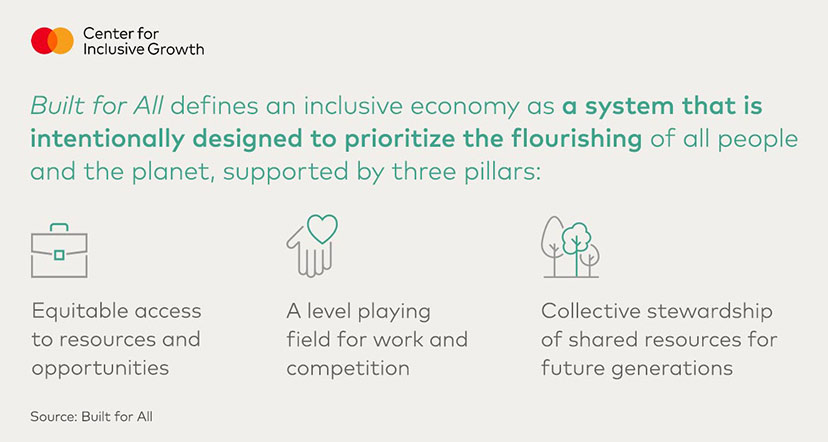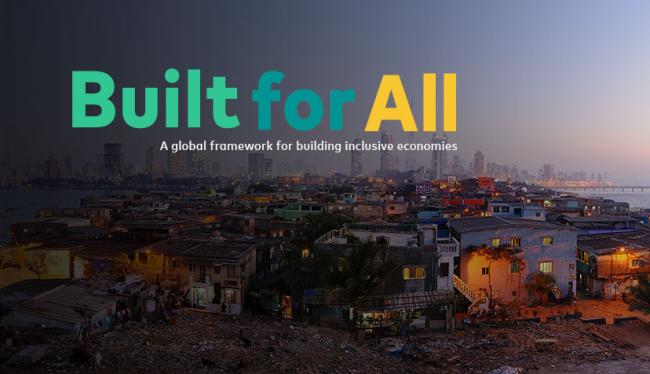Building Blocks for an Inclusive Recovery
It’s been a year or more since people around the world first got acquainted with the words “stay at home order” and “social distancing.” It was the beginning of a year when human contact became dangerous and when a pandemic would expose our frayed social contract and deeply rooted inequities.
But the pandemic also left us with a clear imperative: we cannot return to “normal” because normal wasn’t good enough.
So now begins the hard work of creating meaningful, lasting change. A vaccine will set us on the road to recovery, but a true recovery will take an unprecedented commitment from every sector and industry if we are to reimagine an economic system and society that creates dignity, fairness and equity.
At the Mastercard Center for Inclusive Growth, we’ve been working on issues of inequality and inclusive growth since we launched five years ago, forging new partnerships across sectors to better connect people to the critical networks that power the modern economy so they can contribute to and benefit from its growth.
But the events during the past year forced us to ask a deeper question: What if those networks themselves perpetuate exclusion?
With that question in mind, we joined with the Centre for Public Impact to lead a collaborative exercise in defining what an inclusive economy looks like and to gather insights from some of the world’s leading thinkers on what it will take to reimagine our economic models to address growing inequality and exclusion.
The result is a new framework—called Built for All—to mobilize action across public, private and civic sectors. With a new administration in the White House and governments around the world moving forward with recovery plans, we offer broad actions leaders can take to drive change that advance sustained prosperity, equal participation and collective stewardship of shared resources.
But first, we start with four key takeaways from the experts we consulted to help inform how we tackle the important work ahead.
Expand the measures of economic success
For years, we assumed if the economy was growing and the gross domestic product (GDP) expanding, all was well. But we know now that aggregate measures like GDP only capture the big picture and miss the lived experience for too many.
“GDP only gives you one important dimension: rising outputs that grow incomes at the aggregate level,” said Nobel laureate Michael Spence, senior fellow at the Hoover Institution. “It doesn’t tell you about the distribution of income or assets and value creation. It doesn’t tell you about individual and social well-being, health or economic security.”

Broad measures like GDP also miss the warning signs that some people and places are enjoying a bigger piece of the pie than others, which has been happening for more than a decade in the United States. Between 2010 and 2014, the U.S. created 104,600 net new firms—and thousands of jobs—yet a mere five metro areas were responsible for half of that increase. Nearly 20 years earlier, fully 30 metros shared the growth across all corners of the country. This concentration of opportunity leads directly to compounding inequality.
Places left behind struggle to provide needed services and supports, and residents have fewer opportunities to migrate, said Homi Kharas, senior fellow and deputy director for the Global Economy and Development program at Brookings, trapping them in a vicious cycle of lost opportunity. In the United Kingdom, people who moved to more successful job markets were 2.5 times more likely to earn higher wages than those who stayed behind.
“Internationally, places that are poorer tend to stay poorer and have higher rates of population growth. More people are living in lagging places than they were 30 years ago,” said Kharas.
Redesign systems that reinforce and perpetuate inequity
When we think of the systems in our society that are perpetuating inequality, we rarely think of competition. But competition (or lack of it) can be a driving force behind exclusion.
“We thought that competition would lead to less discrimination in the market,” said Jonathan Morduch, professor of public policy and economics at New York University, “but we are seeing competition that has reinforced existing discrimination and power structures.”
A fair playing field on which to compete is a start. When wealth concentrates at the top in either families or companies, it stifles competition and creates distrust that the game is rigged. A fair playing field instead creates the means to achieve financial security and the ability to act on opportunity, and through that comes inclusive growth.
“I think it’s important to talk about the means to achieve inclusive growth,” said Laura Tyson, former chair of the U.S. president’s Council of Economic Advisers and a professor at University of California at Berkley’s Haas School of Business. “That’s where I start with inequality of opportunity. Income inequality generates opportunity inequality, and opportunity equality is something you need for inclusion.”
Opportunity doesn’t just happen. When the market in which ideas hatch and businesses grow is tilted toward those with the most capital and advantage, the result is a system that benefits only some.
“Today’s overconcentration of wealth at the top is not a matter of redistribution. We need to reform the market structure itself,” said Gabriela Ramos, assistant director-general for social and human sciences at UNESCO. “A ‘grow first and redistribute later’ mentality will never lead to true inclusion.”
The steadily declining startup rates are a warning sign of this competitive imbalance, Ramos said. Case in point: Only 200 firms are working on one of the most life-altering advances, artificial intelligence. “It’s dangerous to have so few firms working on technology that will have large societal consequences,” she warned.
Create incentives for long-term investment
For too long, quarterly profits and shareholder returns have been the driving incentive for companies. But this short-term thinking is no longer sustainable in the face of global and generational issues like climate change.
A shift to longer-term planning will require new incentives so that the purpose of business, “is not to produce profits, but to produce profitable solutions to the problems of people and the planet,” said Colin Mayer, professor of management studies at Oxford University.
“Creating those incentives is where the public sector can help,” said Leora Klapper, lead economist in the finance and private sector research team at the World Bank. “Businesses provide employment, create profits and pay wages. In response to growing calls for a more inclusive economy, the public sector can set up rules and regulations for businesses to follow, which will incentivize more inclusive practices within a democratic society.”
Targeted incentives can also nudge financial systems to broaden their market and bring more lower-income and underserved people into the financial mainstream with appropriate products and services—along with consumer protections—that meet all customers’ unique needs.
Rebuild trust in institutions
Unfair competition and a fraying social contract have been contributing to a long slide in people’s trust in institutions. In the U.S., trust in government has been declining for a decade or more, as has trust in institutions like public schools and the Supreme Court, according to Gallup polls.
“Public and private institutions facilitate people’s social and economic lives,” said Ida Rademacher, vice president of the Aspen Institute, “but the erosion of social capital and the current mistrust in these institutions is proving to be a barrier to inclusion.”
The 2021 Edelman “trust barometer” found continuing declines in government and media trust, leaving business as the most trusted institution. Not only that, this year’s survey revealed a new mandate for business with 68 percent of respondents agreeing that CEOs should step in when the government does not fix societal problems.
To rebuild trust in communities, it is critical that inclusive recovery efforts be co-created at the local level to ensure long-term success. Trusted institutions can help bringing all sectors together and build bridges.
Just the starting point
These four ideas are just a starting point. We will continue to expand our thinking and partnerships to advance a more just world. We do this knowing we are not alone in this pursuit of deeper change. Corporate leaders, NGOs and government must all work together on a new way forward.
“Remember the rule of thumb,” said Shamina Singh, president of the Center, “If you want to go wide, go with government. If you want to go deep, go with NGOS and academic institutions. If you want to go fast, go with the private sector. And if you want to go far, you must go together.”













